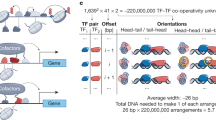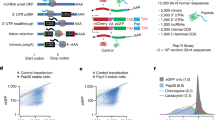Abstract
Functional characterization of noncoding sequences is crucial for understanding the human genome and learning how genetic variation contributes to disease. 3′ untranslated regions (UTRs) are an important class of noncoding sequences, but their functions remain largely uncharacterized1. We developed a method for massively parallel functional annotation of sequences from 3′ UTRs (fast-UTR) and used this approach to measure the effects of a total of >450 kilobases of 3′ UTR sequences from >2,000 human genes on steady-state mRNA abundance, mRNA stability and protein production. We found widespread regulatory effects on mRNA that were coupled to effects on mRNA stability and protein production. Furthermore, we discovered 87 novel cis-regulatory elements and measured the effects of genetic variation within known and novel 3′ UTR motifs. This work shows how massively parallel approaches can improve the functional annotation of noncoding sequences, advance our understanding of cis-regulatory mechanisms and quantify the effects of human genetic variation.
This is a preview of subscription content, access via your institution
Access options
Subscribe to this journal
Receive 12 print issues and online access
$209.00 per year
only $17.42 per issue
Buy this article
- Purchase on Springer Link
- Instant access to full article PDF
Prices may be subject to local taxes which are calculated during checkout



Similar content being viewed by others
References
Zhao, W., Blagev, D., Pollack, J.L. & Erle, D.J. Toward a systematic understanding of mRNA 3′ untranslated regions. Proc. Am. Thorac. Soc. 8, 163–166 (2011).
Barreau, C., Paillard, L. & Osborne, H.B. AU-rich elements and associated factors: are there unifying principles? Nucleic Acids Res. 33, 7138–7150 (2005).
Wickens, M., Bernstein, D.S., Kimble, J. & Parker, R. A PUF family portrait: 3′UTR regulation as a way of life. Trends Genet. 18, 150–157 (2002).
Bartel, D.P. MicroRNAs: target recognition and regulatory functions. Cell 136, 215–233 (2009).
Sharova, L.V. et al. Database for mRNA half-life of 19 977 genes obtained by DNA microarray analysis of pluripotent and differentiating mouse embryonic stem cells. DNA Res. 16, 45–58 (2009).
Chen, C.Y. & Shyu, A.B. AU-rich elements: characterization and importance in mRNA degradation. Trends Biochem. Sci. 20, 465–470 (1995).
Xie, X. et al. Systematic discovery of regulatory motifs in human promoters and 3′ UTRs by comparison of several mammals. Nature 434, 338–345 (2005).
Goodarzi, H. et al. Systematic discovery of structural elements governing stability of mammalian messenger RNAs. Nature 485, 264–268 (2012).
Hafner, M. et al. Transcriptome-wide identification of RNA-binding protein and microRNA target sites by PAR-CLIP. Cell 141, 129–141 (2010).
Thomas, M., Lieberman, J. & Lal, A. Desperately seeking microRNA targets. Nat. Struct. Mol. Biol. 17, 1169–1174 (2010).
Patwardhan, R.P. et al. High-resolution analysis of DNA regulatory elements by synthetic saturation mutagenesis. Nat. Biotechnol. 27, 1173–1175 (2009).
Patwardhan, R.P. et al. Massively parallel functional dissection of mammalian enhancers in vivo. Nat. Biotechnol. 30, 265–270 (2012).
Melnikov, A. et al. Systematic dissection and optimization of inducible enhancers in human cells using a massively parallel reporter assay. Nat. Biotechnol. 30, 271–277 (2012).
Numahata, K. et al. Analysis of the mechanism regulating the stability of rat macrophage inflammatory protein-2 mRNA in RBL-2H3 cells. J. Cell. Biochem. 90, 976–986 (2003).
Bazzini, A.A., Lee, M.T. & Giraldez, A.J. Ribosome profiling shows that miR-430 reduces translation before causing mRNA decay in zebrafish. Science 336, 233–237 (2012).
Djuranovic, S., Nahvi, A. & Green, R. miRNA-mediated gene silencing by translational repression followed by mRNA deadenylation and decay. Science 336, 237–240 (2012).
Guo, H., Ingolia, N.T., Weissman, J.S. & Bartel, D.P. Mammalian microRNAs predominantly act to decrease target mRNA levels. Nature 466, 835–840 (2010).
Wang, S. et al. Nitric oxide activation of Erk1/2 regulates the stability and translation of mRNA transcripts containing CU-rich elements. Nucleic Acids Res. 34, 3044–3056 (2006).
Galgano, A. et al. Comparative analysis of mRNA targets for human PUF-family proteins suggests extensive interaction with the miRNA regulatory system. PLoS ONE 3, e3164 (2008).
Morris, A.R., Mukherjee, N. & Keene, J.D. Ribonomic analysis of human Pum1 reveals cis-trans conservation across species despite evolution of diverse mRNA target sets. Mol. Cell. Biol. 28, 4093–4103 (2008).
Ray, D. et al. A compendium of RNA-binding motifs for decoding gene regulation. Nature 499, 172–177 (2013).
Pedersen, J.S. et al. Identification and classification of conserved RNA secondary structures in the human genome. PLOS Comput. Biol. 2, e33 (2006).
Garcia, D.M. et al. Weak seed-pairing stability and high target-site abundance decrease the proficiency of lsy-6 and other microRNAs. Nat. Struct. Mol. Biol. 18, 1139–1146 (2011).
Sandberg, R., Neilson, J.R., Sarma, A., Sharp, P.A. & Burge, C.B. Proliferating cells express mRNAs with shortened 3′ untranslated regions and fewer microRNA target sites. Science 320, 1643–1647 (2008).
Mayr, C. & Bartel, D.P. Widespread shortening of 3′UTRs by alternative cleavage and polyadenylation activates oncogenes in cancer cells. Cell 138, 673–684 (2009).
Spies, N., Burge, C.B. & Bartel, D.P. 3′ UTR-isoform choice has limited influence on the stability and translational efficiency of most mRNAs in mouse fibroblasts. Genome Res. 23, 2078–2090 (2013).
Lianoglou, S., Garg, V., Yang, J.L., Leslie, C.S. & Mayr, C. Ubiquitously transcribed genes use alternative polyadenylation to achieve tissue-specific expression. Genes Dev. 27, 2380–2396 (2013).
Schork, A.J. et al. All SNPs are not created equal: genome-wide association studies reveal a consistent pattern of enrichment among functionally annotated SNPs. PLoS Genet. 9, e1003449 (2013).
Amendola, M., Venneri, M.A., Biffi, A., Vigna, E. & Naldini, L. Coordinate dual-gene transgenesis by lentiviral vectors carrying synthetic bidirectional promoters. Nat. Biotechnol. 23, 108–116 (2005).
Gossen, M. & Bujard, H. Tight control of gene expression in mammalian cells by tetracycline-responsive promoters. Proc. Natl. Acad. Sci. USA 89, 5547–5551 (1992).
Chen, C.Y. et al. Versatile applications of transcriptional pulsing to study mRNA turnover in mammalian cells. RNA 13, 1775–1786 (2007).
Yuan, J.S., Reed, A., Chen, F. & Stewart, C.N. Jr. Statistical analysis of real-time PCR data. BMC Bioinformatics 7, 85 (2006).
Langmead, B. & Salzberg, S.L. Fast gapped-read alignment with Bowtie 2. Nat. Methods 9, 357–359 (2012).
Li, H. et al. The Sequence Alignment/Map format and SAMtools. Bioinformatics 25, 2078–2079 (2009).
Rice, P., Longden, I. & Bleasby, A. EMBOSS: the European Molecular Biology Open Software Suite. Trends Genet. 16, 276–277 (2000).
Bailey, T.L. DREME: motif discovery in transcription factor ChIP-seq data. Bioinformatics 27, 1653–1659 (2011).
Leppek, K. et al. Roquin promotes constitutive mRNA decay via a conserved class of stem-loop recognition motifs. Cell 153, 869–881 (2013).
Holcik, M. & Liebhaber, S.A. Four highly stable eukaryotic mRNAs assemble 3′ untranslated region RNA-protein complexes sharing cis and trans components. Proc. Natl. Acad. Sci. USA 94, 2410–2414 (1997).
Grant, C.E., Bailey, T.L. & Noble, W.S. FIMO: scanning for occurrences of a given motif. Bioinformatics 27, 1017–1018 (2011).
Yang, E. et al. Decay rates of human mRNAs: correlation with functional characteristics and sequence attributes. Genome Res. 13, 1863–1872 (2003).
Acknowledgements
We thank K.M. Ansel, R. Barbeau, A. Barczak, S.E. Brenner, K. Chin, C. Eisley, E. Ostrin, S.-W. Park, A. Sayce, T. Wang and G. Zhang for advice and technical assistance. We thank A. Shyu (University of Texas Health Science Center at Houston) for providing BEAS-2B tTA cells. This work was supported by research grants (D.J.E.) and a training grant (D.P.B.) from the US National Institutes of Health.
Author information
Authors and Affiliations
Contributions
D.J.E. and W.Z. conceived of key aspects of the project and designed the experiments. W.Z. and D.P.B. carried out the experimental work. M.T.M. contributed to the design and interpretation of the experiments. D.J.E., J.L.P., N.Z. and W.Z. analyzed the data. D.J.E. and W.Z. wrote the manuscript. All authors reviewed and commented on the manuscript.
Corresponding author
Ethics declarations
Competing interests
The authors declare no competing financial interests.
Supplementary information
Supplementary Text and Figures
Supplementary Figures 1–7, Supplementary Tables 1–4, and Supplementary Notes 1 and 2 (PDF 1429 kb)
Supplementary Data 1
CXCL2 fast-UTR genome browser tracks (TXT 26 kb)
Supplementary Data 2
Conserved 3′ UTR segment sequences (XLS 857 kb)
Supplementary Data 3
3′ UTR effects on mRNA levels and stability (XLS 350 kb)
Supplementary Data 4
3′ UTR sequences enriched in sorted cells with high or low reporter protein levels (XLS 90 kb)
Supplementary Data 5
miRNA profiling of BEAS-2B cells (XLS 181 kb)
Supplementary Data 6
Cis-regulatory elements identified using fast-UTR (XLS 87 kb)
Supplementary Data 7
Conserved 3′ UTR segment fast-UTR genome browser tracks (TXT 554 kb)
Rights and permissions
About this article
Cite this article
Zhao, W., Pollack, J., Blagev, D. et al. Massively parallel functional annotation of 3′ untranslated regions. Nat Biotechnol 32, 387–391 (2014). https://doi.org/10.1038/nbt.2851
Received:
Accepted:
Published:
Issue Date:
DOI: https://doi.org/10.1038/nbt.2851
This article is cited by
-
Cumulative effects of weakly repressive regulatory regions in the 3’ UTR maintain PD-1 expression homeostasis in mammals
Communications Biology (2023)
-
Using Synthetic DNA Libraries to Investigate Chromatin and Gene Regulation
Chromosoma (2023)
-
Effects of sequence motifs in the yeast 3′ untranslated region determined from massively parallel assays of random sequences
Genome Biology (2021)
-
Multiplexed functional genomic analysis of 5’ untranslated region mutations across the spectrum of prostate cancer
Nature Communications (2021)
-
Linear models enable powerful differential activity analysis in massively parallel reporter assays
BMC Genomics (2019)



